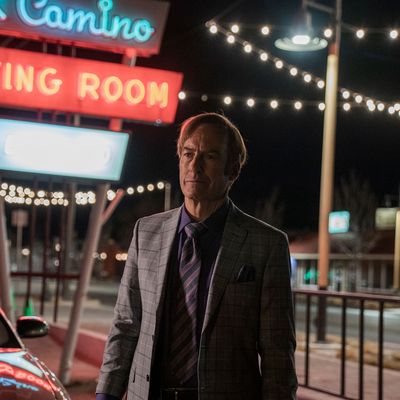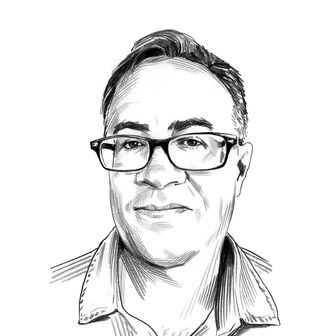
Continuing a tradition of flash-forward, black-and-white scenes to kick off a new season, tonight’s episode of Better Call Saul — the first of a seven-episode half-season, bifurcated just like Breaking Bad — opens with an homage to Citizen Kane, which is nothing if not a show of supreme (and earned) confidence. In Citizen Kane, the camera takes us behind the iron gates of Xanadu, the imposing estate owned by Charles Foster Kane, a newspaper magnate (inspired by real-life mogul William Randolph Hearst) who has lived out his final days in isolation, having alienated anyone who was close to him. His dying word, “Rosebud,” uttered as a snow globe smashes on the floor, is a source of mystery the remainder of the film seeks to solve.
We know that Jimmy McGill did not die at the end of Breaking Bad — and that a bright future as management material at a Cinnabon in Nebraska awaits him — but his Saul Goodman persona certainly does. And Saul Goodman, before fleeing New Mexico, had been living his nouveau riche version of the Kane lifestyle, occupying a garish estate with marble floors and statues, a golden Trump Tower toilet, and an array of pills to numb his conscience and stimulate his erections. (Not sure what to make of that dog-eared copy of H.G. Wells’s The Time Machine other than noting that high-end bathroom reading like Walt Whitman’s Leaves of Grass got Walter White nabbed.) As the camera follows a Saul Goodman standee into the dumpster — shades of Ben Affleck and Ana de Armas there — the “Rosebud” emblem is not a snow globe but a Zafiro Añejo tequila bottle stopper.
“Rosebud” is revealed as the name of Kane’s sled, a symbol of his lost childhood and the simple pleasures it offered. The Zafiro Añejo bottle stopper has a long history, starting with the poisoning of Don Eladio on Breaking Bad, but it’s most relevant as the high-end tequila Jimmy and Kim Wexler used in their first scam together. In “Switch,” the first episode of the second season, Jimmy ropes Kim in on a short con to get a rich, obnoxious stock trader to order the expensive tequila and food then stick him with the bill. The bottle stopper symbolizes their relationship — the terrible fate of which we’ll spend these half-seasons learning — and its foundation in a renegade spirit and a shared hostility toward the elite. Keep in mind: Kim may have eventually walked away as “Slippin’ Jimmy” fully became Saul Goodman, but she’s his wife for a reason.
That Cadillac with the “LAYRUP” license plate in the beginning? In “Wine and Roses,” we learn that Kim suggests that Saul would drive that kind of car — flashy but American. His current ride is a sputtering brown Ford Taurus, which could be understood either as a show of humility to his clients or a scrappy, doing-it-for-the-little-guy self-image he wants to protect. Kim tells Jimmy that Saul should have a “showy American car,” which would really scream “success” to future clients, and she adds that he should open up an equally eye-catching office location, “a cathedral of justice.” She says she should start looking for Jimmy but corrects herself. They should start looking for Saul. The cognitive dissonance here will only get louder.
But after that opening flash-forward, “Wine and Roses” picks up right where season five left off, with Nacho cracking open the gate at Lalo’s Chihuahua compound and letting Gus’s assassins in to miss their target. Nacho succeeds in tiptoeing through Salamanca territory, where both cartel henchmen and bribed federales are on the hunt for him, but there’s concern back in Albuquerque that reports of Lalo’s death may be greatly exaggerated. In a meeting with Gus, Mike states the obvious: “The mercenaries are dead, to a man, and yet their mission was a success.” It seems as though Gus is shrewd enough to draw this conclusion himself, but Lalo is happy to allow people to believe he’s gone so he can mount his own attack.
The fascinating wrinkle in this situation is Mike’s strained relationship with Gus, whose cool efficiency and professionalism appeal to Mike but whose unremitting ruthlessness does not. To Mike, the first priority in this situation is to extract Nacho from Mexico and bring him back with the goal of rewarding him for his role in an operation that will put him in the Salamanca family’s crosshairs forever. He showed loyalty to Gus, and Gus should show loyalty to him (“He played a tough game, and he played it on the square”). But that’s not the business Nacho is in, and as much as Gus approaches the drug trade with a certain corporate reserve, he’s no different from the Salamancas when it comes to human resources. He would never let Nacho leave out of loyalty. His only thought is about whether or how Nacho is useful to him. He’d just as soon leave him to die in Mexico if it was the expedient thing to do.
The revenge plot against Lalo may have gone wrong, but the first step in Jimmy and Kim’s plan to take out their own grievances against Howard has gone swimmingly so far despite a couple of moments when Jimmy needed to improvise his way out of a tight spot. While Howard and Clifford Main (Ed Begley Jr.), his one-time boss at Davis & Main, are out hitting the links, Jimmy goes on the tour of their country club to sneak into the locker room and plant cocaine on Howard. The plan blows up when Kevin Wachtell, the Mesa Verde honcho whom Jimmy trolled last season, makes it clear to the membership director (a typically delightful James Urbaniak) that “Saul Goodman” cannot be a member of the club. Crisis turns into opportunity for Jimmy, who gets to make a scene at the club (“It’s wall-to-wall mayonnaise in here”) while huffing his way into the locker room anyway.
As usual, Jimmy takes on more risks than he should, but from his perspective, the chance to razz one group of elites while targeting another is a win-win. Perhaps he and Kim will pop the cork on another bottle of Zafiro Añejo when this is over.
Slippin’ Jimmies
• Tied to Mike’s concern over Gus’s dishonorable treatment of Nacho is Nacho’s concern over Gus’s assassins failing to distinguish Lalo and his henchmen from the ordinary people working on the estate. And sure enough, we get an overhead shot of about a dozen body bags laid out on the estate lawn, implying that Gus didn’t really care about such collateral damage.
• Though Kim is all in on the Howard scheme, she makes a point of tossing the bullet-riddled coffee thermos Jimmy went through such pains to keep during his misadventure in the desert. To Kim, it’s a reminder of how close Jimmy was to losing his life and, more crucially, a reminder of his willingness to deceive her. That’s not a memento she wishes to keep.
• The shot of Jimmy stepping out of the car with the El Camino Dining Room sign behind him is mount-it-on-the-wall-worthy, and the scene that follows, with Kim wrapping up a meeting with clients and telling Jimmy about her cases, is beautiful too. “Sounds like the day from hell,” says Jimmy after hearing the full rundown. “It was one of the best days of my life,” replies Kim. She’s finally practicing law on her own terms.
• A hilarious exchange between Wachtell and Jimmy when Jimmy implies that the club refusing Saul Goodman as a member is antisemitic. “You’re about as Jewish as my Aunt Fanny.” “Five thousand years, and it never ends.”


